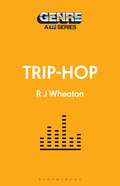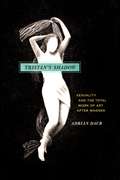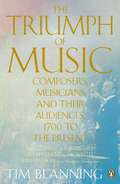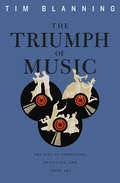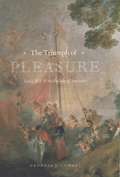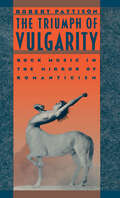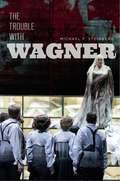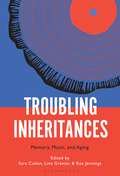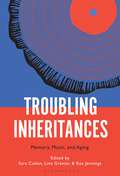- Table View
- List View
Trinity Grade 5 Theory Past Papers 2019
by Trinity College London PressTrinity Grade 5 Theory Past Papers 2019
Trinity Grade 6 Theory Model Answers 2019
by Trinity College London PressTrinity Grade 6 Theory Model Answers 2019
Trinity Grade 6 Theory Past Papers 2019
by Trinity College London PressTrinity Grade 6 Theory Past Papers 2019
Trinity Grade 7 Theory Model Answers 2019
by Trinity College London PressTrinity Grade 7 Theory Model Answers 2019
Trinity Grade 7 Theory Past Papers 2019
by Trinity College London PressTrinity Grade 7 Theory Past Papers 2019
Trinity Grade 8 Theory Model Answers 2019
by Trinity College London PressTrinity Grade 8 Theory Model Answers 2019
Trinity Grade 8 Theory Past Papers 2019
by Trinity College London PressTrinity Grade 8 Theory Past Papers 2019
Trip-Hop (Genre: A 33 1/3 Series)
by R.J. WheatonTrip-hop described some of the 1990s' best music, and it was one of the decade's most revealing bad ideas. The music itself was an intoxication of beats, bass, and voice. It emerged amid the social tensions of the late 1980s, and as part of hip-hop's rise to global dominance. It carried the innovations of Jamaican soundsystem culture, the sweet refuge of Lovers Rock, the bliss of club jazz dancefloors and post-rave chill-out rooms. It went mainstream with Massive Attack, Portishead, Tricky, DJ Shadow, Kruder & Dorfmeister, and Björk; and with record labels like Ninja Tune and Mo' Wax. To the artists' despair, the music was tagged with a silly label and packaged as music for the boutique and the lounge; made respectable with awards and acclaim. But the music at its best still sounds experimental and dramatic; and its influence lingers through artists like FKA twigs, Sevdaliza, James Blake, Billie Eilish, and Lana Del Rey. This short book is a guide to 'trip-hop' in its context of the weird 1990s: nostalgia and consumerism; pre-millenium angst and lo-fi technology; casual exoticism amid accelerating globalization and gentrification. This book presents a survey of the music and its leading artists, packed with recommended listening, essential tracks, great remixes, and under-recognized albums.
Trip-Hop (Genre: A 33 1/3 Series)
by R.J. WheatonTrip-hop described some of the 1990s' best music, and it was one of the decade's most revealing bad ideas. The music itself was an intoxication of beats, bass, and voice. It emerged amid the social tensions of the late 1980s, and as part of hip-hop's rise to global dominance. It carried the innovations of Jamaican soundsystem culture, the sweet refuge of Lovers Rock, the bliss of club jazz dancefloors and post-rave chill-out rooms. It went mainstream with Massive Attack, Portishead, Tricky, DJ Shadow, Kruder & Dorfmeister, and Björk; and with record labels like Ninja Tune and Mo' Wax. To the artists' despair, the music was tagged with a silly label and packaged as music for the boutique and the lounge; made respectable with awards and acclaim. But the music at its best still sounds experimental and dramatic; and its influence lingers through artists like FKA twigs, Sevdaliza, James Blake, Billie Eilish, and Lana Del Rey. This short book is a guide to 'trip-hop' in its context of the weird 1990s: nostalgia and consumerism; pre-millenium angst and lo-fi technology; casual exoticism amid accelerating globalization and gentrification. This book presents a survey of the music and its leading artists, packed with recommended listening, essential tracks, great remixes, and under-recognized albums.
Tristan's Shadow: Sexuality and the Total Work of Art after Wagner
by Adrian DaubDas Rheingold, Die Walküre, and Siegfried. Parsifal. Tristan und Isolde. Both revered and reviled, Richard Wagner conceived some of the nineteenth century’s most influential operas—and created some of the most indelible characters ever to grace the stage. But over the course of his polarizing career, Wagner also composed volumes of essays and pamphlets, some on topics seemingly quite distant from the opera house. His influential concept of Gesamtkunstwerk—the “total work of art”—famously and controversially offered a way to unify the different media of an opera into a coherent whole. Less well known, however, are Wagner’s strange theories on sexuality—like his ideas about erotic acoustics and the metaphysics of sexual difference. Drawing on the discourses of psychoanalysis, evolutionary biology, and other emerging fields of study that informed Wagner’s thinking, Adrian Daub traces the dual influence of Gesamtkunstwerk and eroticism from their classic expressions in Tristan und Isolde into the work of the generation of composers that followed, including Zemlinsky, d’Albert, Schreker, and Strauss. For decades after Wagner’s death, Daub writes, these composers continued to grapple with his ideas and with his overwhelming legacy, trying in vain to write their way out from Tristan’s shadow.
Tristan's Shadow: Sexuality and the Total Work of Art after Wagner
by Adrian DaubDas Rheingold, Die Walküre, and Siegfried. Parsifal. Tristan und Isolde. Both revered and reviled, Richard Wagner conceived some of the nineteenth century’s most influential operas—and created some of the most indelible characters ever to grace the stage. But over the course of his polarizing career, Wagner also composed volumes of essays and pamphlets, some on topics seemingly quite distant from the opera house. His influential concept of Gesamtkunstwerk—the “total work of art”—famously and controversially offered a way to unify the different media of an opera into a coherent whole. Less well known, however, are Wagner’s strange theories on sexuality—like his ideas about erotic acoustics and the metaphysics of sexual difference. Drawing on the discourses of psychoanalysis, evolutionary biology, and other emerging fields of study that informed Wagner’s thinking, Adrian Daub traces the dual influence of Gesamtkunstwerk and eroticism from their classic expressions in Tristan und Isolde into the work of the generation of composers that followed, including Zemlinsky, d’Albert, Schreker, and Strauss. For decades after Wagner’s death, Daub writes, these composers continued to grapple with his ideas and with his overwhelming legacy, trying in vain to write their way out from Tristan’s shadow.
Tristan's Shadow: Sexuality and the Total Work of Art after Wagner
by Adrian DaubDas Rheingold, Die Walküre, and Siegfried. Parsifal. Tristan und Isolde. Both revered and reviled, Richard Wagner conceived some of the nineteenth century’s most influential operas—and created some of the most indelible characters ever to grace the stage. But over the course of his polarizing career, Wagner also composed volumes of essays and pamphlets, some on topics seemingly quite distant from the opera house. His influential concept of Gesamtkunstwerk—the “total work of art”—famously and controversially offered a way to unify the different media of an opera into a coherent whole. Less well known, however, are Wagner’s strange theories on sexuality—like his ideas about erotic acoustics and the metaphysics of sexual difference. Drawing on the discourses of psychoanalysis, evolutionary biology, and other emerging fields of study that informed Wagner’s thinking, Adrian Daub traces the dual influence of Gesamtkunstwerk and eroticism from their classic expressions in Tristan und Isolde into the work of the generation of composers that followed, including Zemlinsky, d’Albert, Schreker, and Strauss. For decades after Wagner’s death, Daub writes, these composers continued to grapple with his ideas and with his overwhelming legacy, trying in vain to write their way out from Tristan’s shadow.
Tristan's Shadow: Sexuality and the Total Work of Art after Wagner
by Adrian DaubDas Rheingold, Die Walküre, and Siegfried. Parsifal. Tristan und Isolde. Both revered and reviled, Richard Wagner conceived some of the nineteenth century’s most influential operas—and created some of the most indelible characters ever to grace the stage. But over the course of his polarizing career, Wagner also composed volumes of essays and pamphlets, some on topics seemingly quite distant from the opera house. His influential concept of Gesamtkunstwerk—the “total work of art”—famously and controversially offered a way to unify the different media of an opera into a coherent whole. Less well known, however, are Wagner’s strange theories on sexuality—like his ideas about erotic acoustics and the metaphysics of sexual difference. Drawing on the discourses of psychoanalysis, evolutionary biology, and other emerging fields of study that informed Wagner’s thinking, Adrian Daub traces the dual influence of Gesamtkunstwerk and eroticism from their classic expressions in Tristan und Isolde into the work of the generation of composers that followed, including Zemlinsky, d’Albert, Schreker, and Strauss. For decades after Wagner’s death, Daub writes, these composers continued to grapple with his ideas and with his overwhelming legacy, trying in vain to write their way out from Tristan’s shadow.
The Triumph of Music: Composers, Musicians and Their Audiences, 1700 to the Present (Penguin Modern Classics)
by Tim BlanningOnce musicians such as Mozart were little more than court servants; now they are multimillionaire superstars wielding more power than politicians. How did this extraordinary change come about? Tim Blanning's brilliantly enjoyable book examines how everything from the cult of the romantic to technology and travel all fed the inexorable rise of music in the West, making it the most dominant and ubiquitous of the art forms. Encompassing balladeers, the great composers, jazz legends and rock gods, this is an enthralling story of power, patronage, creativity and genius.
The Triumph of Music: The Rise of Composers, Musicians and Their Art
by Tim BlanningA distinguished historian chronicles the rise of music and musicians in the West from lowly balladeers to masters employed by fickle patrons, to the great composers of genius, to today’s rock stars. How, he asks, did music progress from subordinate status to its present position of supremacy among the creative arts? Mozart was literally booted out of the service of the Archbishop of Salzburg “with a kick to my arse,” as he expressed it. Yet, less than a hundred years later, Europe’s most powerful ruler—Emperor William I of Germany—paid homage to Wagner by traveling to Bayreuth to attend the debut of The Ring. Today Bono, who was touted as the next president of the World Bank in 2006, travels the world, advising politicians—and they seem to listen. The path to fame and independence began when new instruments allowed musicians to showcase their creativity, and music publishing allowed masterworks to be performed widely in concert halls erected to accommodate growing public interest. No longer merely an instrument to celebrate the greater glory of a reigning sovereign or Supreme Being, music was, by the nineteenth century, to be worshipped in its own right. In the twentieth century, new technological, social, and spatial forces combined to make music ever more popular and ubiquitous. In a concluding chapter, Tim Blanning considers music in conjunction with nationalism, race, and sex. Although not always in step, music, society, and politics, he shows, march in the same direction.
The Triumph of Pleasure: Louis XIV and the Politics of Spectacle
by Georgia J. CowartProminent components of Louis XIV’s propaganda, the arts of spectacle also became sources of a potent resistance to the monarchy in late seventeenth-century France. With a particular focus on the court ballet, comedy-ballet, opera, and opera-ballet, Georgia J. Cowart tells the long-neglected story of how the festive arts deployed an intricate network of subversive satire to undermine the rhetoric of sovereign authority. With bold revisionist strokes, Cowart traces this strain of artistic dissent through the comedy-ballets of Jean-Baptiste Lully and Molière, the late operatic works of Lully and the operas of his sons, the opera-ballets of André Campra and his contemporaries, and the related imagery of Antoine Watteau’s well-known painting The Pilgrimage to Cythera. She contends that through a variety of means, including the parody of old-fashioned court entertainments, these works reclaimed traditional allegories for new ideological aims, setting the tone for the Enlightenment. Exploring these arts from the perspective of spectacle as it emerged from the court into the Parisian public sphere, Cowart ultimately situates the ballet and related genres as the missing link between an imagery of propaganda and an imagery of political protest.
The Triumph of Vulgarity: Rock Music in the Mirror of Romanticism
by Robert PattisonThe Triumph of Vulgarity in a thinker's guide to rock 'n' roll. Rock music mirrors the tradition of nineteenth-century Romaniticsm, Robert Patison says. Whitman's "barbaric yawp" can still be heard in the punk rock of the Ramones, and the spirit that inspired Poe's Eureka lives on in the lyrics of Talking Heads. Rock is vulgar, Pattison notes, and vulgarity is something that high culture has long despised but rarely bothered to define. This book is the first effort since John Ruskin and Aldous Huxley to describe in depth what vulgarity is, and how, with the help of ideas inherent in Romaniticism, it has slipped the constraints imposed on it by refined culture and established its own loud arts. The book disassembles the various myths of rock: its roots in black and folk music; the primacy it accords to feeling and self; the sexual omnipotence of rock stars; the satanic predilictions of rock fans; and rock's high-voltage image of the modern Prometheus wielding an electric guitar. Pattison treats these myths as vulgar counterparts of their originals in refined Romantic art and offers a description and justification of rock's central place in the social and aesthetic structure of modern culture. At a time when rock lyrics have provoked parental outrage and senatorial hearings, The Triumph of Vulgarity is required reading for anyone interested in where rock comes from and how it works.
Trombone (tactile)
by Markeaton SchoolThis is a tactile silhouette of a trombone seen from the side. The trombones bell, where the sound comes out, is to the left centre of the page. The slide and the trombones mouthpiece are on the right of the image.
The Trouble with Wagner
by Michael P. SteinbergIn this unique and hybrid book, cultural and music historian Michael P. Steinberg combines a close analysis of Wagnerian music drama with a personal account of his work as a dramaturg on the bicentennial production of The Ring of the Nibelung for the Teatro alla Scala Milan and the Berlin State Opera. Steinberg shows how Wagner uses the power of a modern mythology to heighten music’s claims to knowledge, thereby fusing not only art and politics, but truth and lies as well. Rather than attempting to separate value and violence, or “the good from the bad,” as much Wagner scholarship as well as popular writing have tended to do, Steinberg proposes that we confront this paradox and look to the capacity of the stage to explore its depths and implications. Drawing on decades of engagement with Wagner and of experience teaching opera across disciplines, The Trouble with Wagner is packed with novel insights for experts and interested readers alike.
The Trouble with Wagner
by Michael P. SteinbergIn this unique and hybrid book, cultural and music historian Michael P. Steinberg combines a close analysis of Wagnerian music drama with a personal account of his work as a dramaturg on the bicentennial production of The Ring of the Nibelung for the Teatro alla Scala Milan and the Berlin State Opera. Steinberg shows how Wagner uses the power of a modern mythology to heighten music’s claims to knowledge, thereby fusing not only art and politics, but truth and lies as well. Rather than attempting to separate value and violence, or “the good from the bad,” as much Wagner scholarship as well as popular writing have tended to do, Steinberg proposes that we confront this paradox and look to the capacity of the stage to explore its depths and implications. Drawing on decades of engagement with Wagner and of experience teaching opera across disciplines, The Trouble with Wagner is packed with novel insights for experts and interested readers alike.
The Trouble with Wagner
by Michael P. SteinbergIn this unique and hybrid book, cultural and music historian Michael P. Steinberg combines a close analysis of Wagnerian music drama with a personal account of his work as a dramaturg on the bicentennial production of The Ring of the Nibelung for the Teatro alla Scala Milan and the Berlin State Opera. Steinberg shows how Wagner uses the power of a modern mythology to heighten music’s claims to knowledge, thereby fusing not only art and politics, but truth and lies as well. Rather than attempting to separate value and violence, or “the good from the bad,” as much Wagner scholarship as well as popular writing have tended to do, Steinberg proposes that we confront this paradox and look to the capacity of the stage to explore its depths and implications. Drawing on decades of engagement with Wagner and of experience teaching opera across disciplines, The Trouble with Wagner is packed with novel insights for experts and interested readers alike.
The Trouble with Wagner
by Michael P. SteinbergIn this unique and hybrid book, cultural and music historian Michael P. Steinberg combines a close analysis of Wagnerian music drama with a personal account of his work as a dramaturg on the bicentennial production of The Ring of the Nibelung for the Teatro alla Scala Milan and the Berlin State Opera. Steinberg shows how Wagner uses the power of a modern mythology to heighten music’s claims to knowledge, thereby fusing not only art and politics, but truth and lies as well. Rather than attempting to separate value and violence, or “the good from the bad,” as much Wagner scholarship as well as popular writing have tended to do, Steinberg proposes that we confront this paradox and look to the capacity of the stage to explore its depths and implications. Drawing on decades of engagement with Wagner and of experience teaching opera across disciplines, The Trouble with Wagner is packed with novel insights for experts and interested readers alike.
Troubling Inheritances: Memory, Music, and Aging
by Sara Cohen, Line Grenier, Ros JenningsThis book provides an interdisciplinary focus on music, memory, and ageing by examining how they intersect outside of a formal therapeutic context or framework and by offering a counter-narrative to age as decline. It contributes to the development of qualitative research methodologies by utilizing and reflecting on methods for studying music, memory, and ageing across diverse and interconnected contexts. Using the notion of inheritance to trouble its core themes of music, memory, ageing, and methodology, it examines different ways in which the concept of inheritance is understood but also how it commonly refers to the practice of passing on, and the connections this establishes across time and space. It confronts the ageist discourses that associate popular music predominantly with youth and that focus narrowly, and almost exclusively, on music's therapeutic function for older adults. By presenting research which examines various intersections of music and ageing outside of a therapeutic context or framework, the book brings a much-needed intervention.
Troubling Inheritances: Memory, Music, and Aging
This book provides an interdisciplinary focus on music, memory, and ageing by examining how they intersect outside of a formal therapeutic context or framework and by offering a counter-narrative to age as decline. It contributes to the development of qualitative research methodologies by utilizing and reflecting on methods for studying music, memory, and ageing across diverse and interconnected contexts. Using the notion of inheritance to trouble its core themes of music, memory, ageing, and methodology, it examines different ways in which the concept of inheritance is understood but also how it commonly refers to the practice of passing on, and the connections this establishes across time and space. It confronts the ageist discourses that associate popular music predominantly with youth and that focus narrowly, and almost exclusively, on music's therapeutic function for older adults. By presenting research which examines various intersections of music and ageing outside of a therapeutic context or framework, the book brings a much-needed intervention.

